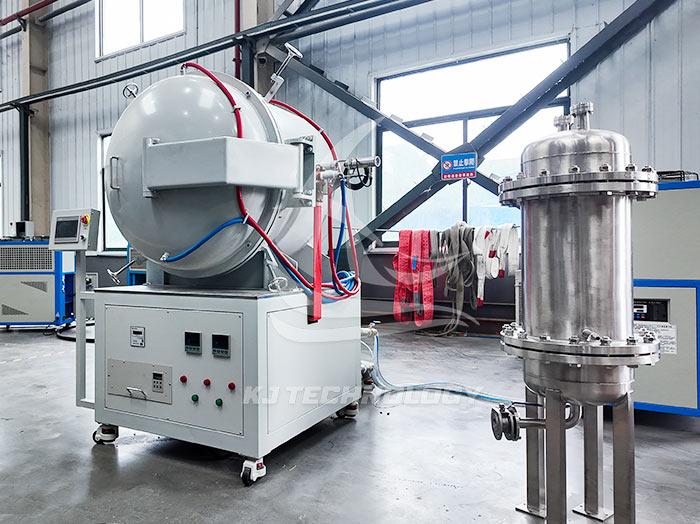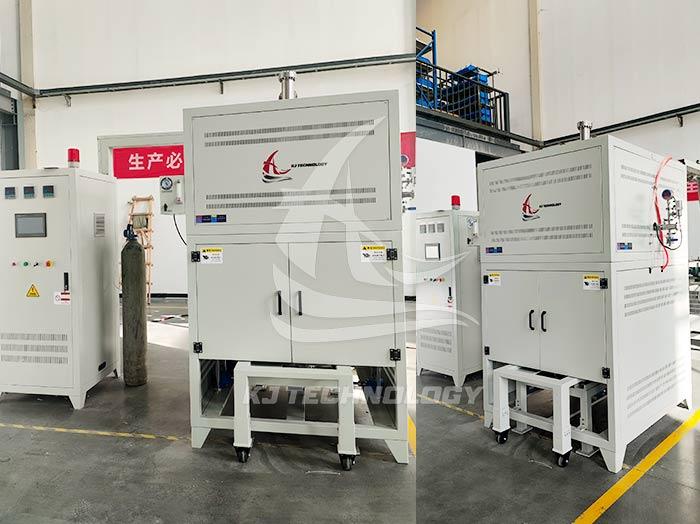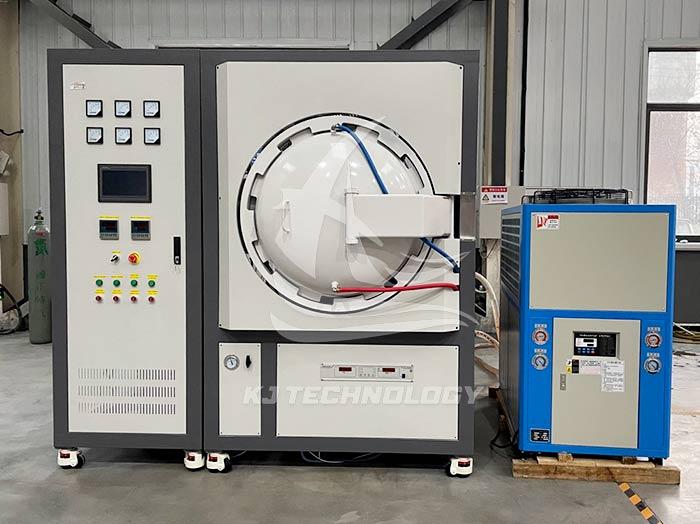Vertical vacuum hot pressing furnace for processing silicon carbide
 09-18-2025 Author: KJ technology
09-18-2025 Author: KJ technology
The vertical vacuum hot press furnace has significant advantages in processing silicon carbide. Through the synergistic effect of high temperature, high pressure, and vacuum environment, it can achieve high densification, excellent performance improvement, and diversified applications of silicon carbide materials.
1. Technical principles and core advantages
The role of vacuum environment
Exclude gases and volatile impurities from silicon carbide materials, avoid high-temperature oxidation (silicon carbide is prone to react with oxygen above 1600 ℃ to generate SiO ₂ and CO ₂), and ensure the purity of the material's chemical composition.
Promote gas escape, reduce porosity, and improve material density.
The synergistic effect of high temperature and high pressure
High temperature: The sintering temperature of silicon carbide is usually 1800-2200 ℃. The vertical vacuum hot press furnace can provide a stable high temperature environment through graphite heating elements or induction heating systems.
High pressure: Apply 5-30 tons of pressure through the hydraulic system to promote particle bonding, eliminate pores, and achieve high densification. For example, when boron carbide is hot pressed and sintered at 2150 ℃ for 10 minutes, its relative density can reach 91.6%, which is much higher than the 80% -87% sintered at normal pressure.
Advantages of vertical structure: Under the action of gravity, the pressure distribution is uniform, reducing workpiece deformation, and suitable for sintering large-sized or complex shaped silicon carbide products.
Automation Control and Process Stability
Adopting PID self-tuning function or intelligent program PID control, the temperature accuracy reaches ± 1 ℃, ensuring the consistency of the sintering process.
Support programmable automatic control, record and analyze sintering process data, and optimize process parameters.
2. Key process parameters for silicon carbide sintering
temperature control
Maximum temperature: 2200-2400 ℃ (some models can reach 2500 ℃), meeting the high-temperature sintering requirements of silicon carbide.
Temperature uniformity: ≤± 5 ℃, ensuring consistency in material properties.
Vacuum requirement
Ultimate vacuum degree: ≤ 5 × 10 ⁻ ³ Pa, effectively eliminating gas residues.
Working vacuum degree: usually ≤ 1 × 10 ⁻ ² Pa, meeting the requirements of silicon carbide sintering.
Pressure system configuration
Pressure range: adjustable from 5-30 tons, with an accuracy of ± 0.01MPa.
Pressure head design: Made of graphite or high-strength alloy materials, resistant to high temperature and high pressure, ensuring long-term stability.
Cooling System Design
Rapid cooling: By using water cooling or helium cooling, the production cycle can be shortened.
Cooling speed: It can be filled with protective gas (such as nitrogen) to accelerate cooling and prevent cracking.
3. Typical application scenarios
Preparation of high-performance silicon carbide ceramics
Application areas: aerospace (turbine blades, thermal protection systems), nuclear energy (fuel cladding, control rods), semiconductors (substrates, heat dissipation substrates), mechanical manufacturing (bearings, seals).
Performance improvement: After hot pressing sintering, the hardness, strength, and wear resistance of silicon carbide ceramics are significantly improved, for example:
Hardness: close to diamond.
Fracture toughness: Enhance and reduce the risk of brittle fracture.
Processing of Silicon Carbide Composite Materials
Application case: Silicon carbide fiber-reinforced ceramic matrix composites (CMCs) used for hot end components of aircraft engines.
Process advantages: Vacuum hot pressing sintering can achieve a strong bond between ceramics and metals, with high joint strength and high temperature corrosion resistance.
Functional Ceramics and Electronic Devices
Application areas: Transparent ceramics (such as infrared windows), bioceramics (such as artificial joints), electronic packaging materials.
Process features: By controlling the amount of sintering additives (such as Al ₂ O ∝ - Y ₂ O ∝) added, grain refinement can be achieved, and material transmittance or electrical properties can be improved.
4. Equipment selection suggestions
Matching temperature and pressure requirements
Select appropriate temperature range and pressure parameters based on the type of silicon carbide material (such as α - SiC, β - SiC).
For example, sintering boron carbide requires a high temperature of over 2200 ℃ and a pressure of 20-30 tons.
Optimization of Vacuum System Configuration
Prioritize the combination of mechanical pump+diffusion pump or molecular pump to ensure that the ultimate vacuum degree is ≤ 5 × 10 ⁻ ³ Pa.
Configure vacuum tubes, pneumatic high vacuum butterfly valves, etc. to improve system sealing.
Selection of heating elements and insulation materials
Heating element: Graphite tube is suitable for high temperature scenarios (>2000 ℃), while molybdenum wire is suitable for medium and low temperature scenarios.
Thermal insulation material: using multi-layer graphite felt or ceramic fibers to reduce heat loss and improve temperature uniformity.
Automation and Security Design
Control system: Supports PLC touch screen operation and has interlock alarm functions for over temperature, over pressure, and water pressure.
Safety design: equipped with sound and light alarm, emergency stop button to ensure safe operation.








